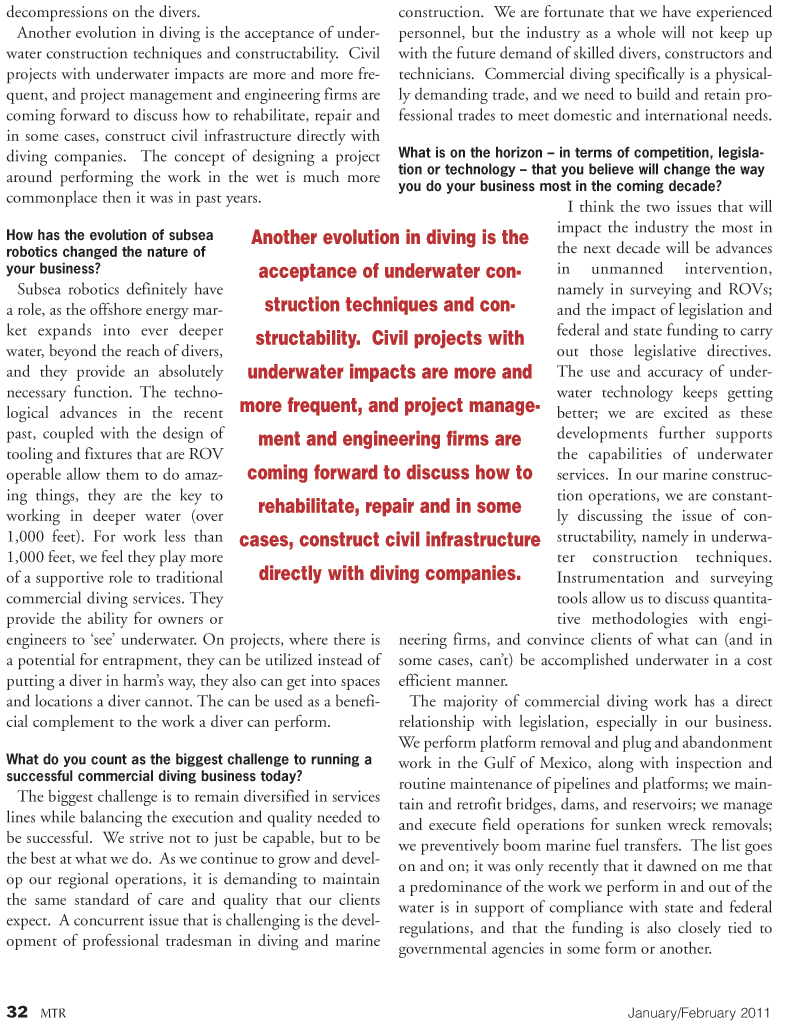
Page 32: of Marine Technology Magazine (January 2011)
Marine Salvage & Recovery
Read this page in Pdf, Flash or Html5 edition of January 2011 Marine Technology Magazine
32 MTR January/February 2011 decompressions on the divers.
Another evolution in diving is the acceptance of under- water construction techniques and constructability. Civil projects with underwater impacts are more and more fre- quent, and project management and engineering firms are coming forward to discuss how to rehabilitate, repair and in some cases, construct civil infrastructure directly with diving companies. The concept of designing a project around performing the work in the wet is much more commonplace then it was in past years.
How has the evolution of subsea robotics changed the nature of your business?
Subsea robotics definitely have a role, as the offshore energy mar- ket expands into ever deeper water, beyond the reach of divers, and they provide an absolutely necessary function. The techno- logical advances in the recent past, coupled with the design of tooling and fixtures that are ROV operable allow them to do amaz- ing things, they are the key to working in deeper water (over 1,000 feet). For work less than 1,000 feet, we feel they play more of a supportive role to traditional commercial diving services. They provide the ability for owners or engineers to ‘see’ underwater. On projects, where there is a potential for entrapment, they can be utilized instead of putting a diver in harm’s way, they also can get into spaces and locations a diver cannot. The can be used as a benefi- cial complement to the work a diver can perform.
What do you count as the biggest challenge to running a successful commercial diving business today?
The biggest challenge is to remain diversified in services lines while balancing the execution and quality needed to be successful. We strive not to just be capable, but to be the best at what we do. As we continue to grow and devel- op our regional operations, it is demanding to maintain the same standard of care and quality that our clients expect. A concurrent issue that is challenging is the devel- opment of professional tradesman in diving and marine construction. We are fortunate that we have experienced personnel, but the industry as a whole will not keep up with the future demand of skilled divers, constructors and technicians. Commercial diving specifically is a physical- ly demanding trade, and we need to build and retain pro- fessional trades to meet domestic and international needs.
What is on the horizon – in terms of competition, legisla- tion or technology – that you believe will change the way you do your business most in the coming decade?
I think the two issues that will impact the industry the most in the next decade will be advances in unmanned intervention, namely in surveying and ROVs; and the impact of legislation and federal and state funding to carry out those legislative directives.
The use and accuracy of under- water technology keeps getting better; we are excited as these developments further supports the capabilities of underwater services. In our marine construc- tion operations, we are constant- ly discussing the issue of con- structability, namely in underwa- ter construction techniques.
Instrumentation and surveying tools allow us to discuss quantita- tive methodologies with engi- neering firms, and convince clients of what can (and in some cases, can’t) be accomplished underwater in a cost efficient manner.
The majority of commercial diving work has a direct relationship with legislation, especially in our business.
We perform platform removal and plug and abandonment work in the Gulf of Mexico, along with inspection and routine maintenance of pipelines and platforms; we main- tain and retrofit bridges, dams, and reservoirs; we manage and execute field operations for sunken wreck removals; we preventively boom marine fuel transfers. The list goes on and on; it was only recently that it dawned on me that a predominance of the work we perform in and out of the water is in support of compliance with state and federal regulations, and that the funding is also closely tied to governmental agencies in some form or another.
Another evolution in diving is the acceptance of underwater con- struction techniques and con- structability. Civil projects with underwater impacts are more and more frequent, and project manage- ment and engineering firms are coming forward to discuss how to rehabilitate, repair and in some cases, construct civil infrastructure directly with diving companies.

 31
31

 33
33
